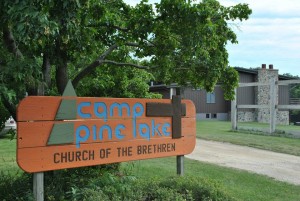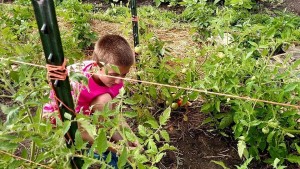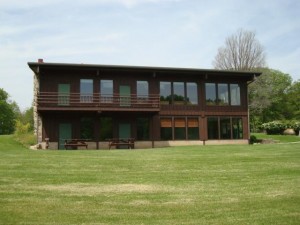Did You Know: LIFE OF A MISSIONARY COUPLE IN NIGERIA—Dick and Ann Burger
Richard and Ann Burger were appointed to the Nigerian mission field in 1944, arriving there in time for the New Year in 1945. Richard (Dick) was born in Waterloo, Iowa in 1920. As a child he attended Fairview church of the Brethren near Unionville, IA. Ann Witmore Burger was born in Rich Hill, Missouri in 1924, and attended Happy Hill Brethren congregation in Bates County, MO. They met at McPherson College. Ann completed her college experience in Chicago while Dick attended Bethany Seminary in Elgin, IL.
Dick’s path to ministry was greatly influenced by his parents, his pastor Orlando Ogden, Camp Pine Lake experiences with Desmond Bittinger, Dad Kahl from Virginia, a Christian Church missionary to the Belgian Congo who spoke at the Christian Church in Udell, and other Brethren missionaries who spoke at Fairview Church of the Brethren. Dick began speaking at Fairview under the direction of pastor Orlando Ogden. Dick led many junior high and youth camp experiences and spoke at Sheldon, IA at the youth conference for the District of Northern Iowa.
“Dad Kahl used an illustration to demonstrate his concern for youth learning about the simple life. He asked for a woman volunteer to let him use her purse. He dumped the contents on the table for all to see; then he taught us how to thrive in a world where the economy has tanked. That was in a time when the Brethren still believed in the ‘simple life’. I was impressed by two things then and I embraced them into my lifestyle. 1) Live on your income and 2) save a little something. I accepted these teachings as essentials into my manner of living.”
Dick was also greatly influenced by his sister Melba; she took jobs as soon as she was able, then saved money for college to become a teacher. She attended McPherson College one year, then encouraged Dick to attend a camp for young adults at Camp Pine Lake and McPherson College. During college, Dick decided to become a missionary. Melba and her husband from Waterloo City church also became missionaries in Nigeria for one term and lived close to Dick. Melba is still living in the Washington D.C. area and is 98 years old. Wayne taught at a university in that area before his death.
Dick was in high school when Nigerian missionary Desmond Bittinger came to Fairview to speak at the Southern Iowa District’s youth conference; the event heightened his interest in becoming a missionary and he explored the possibility of becoming one. During his junior year at McPherson College, Dr. Bitttinger was his teacher. Dick believed he could belong to the Fairview community AND become a rural missionary to Nigeria. Dick had noted that in Nigeria, many were moving away from the rural areas to seek work in cities—just like Southern Iowa.
After their marriage in August 1943 and return to seminary and college, Dick and Ann’s commitment to become missionaries flourished. In 1944 they were officially appointed to the Nigeria mission; they began to prepare. The mission board at Elgin gave us an allowance of $1400 to equip them for the first three year term. In the summer of 1944, Dick bought a bench saw, making and packing 42 boxes in his parents’ basement to ship to Nigeria which were shipped on the Rock Island railroad from nearby Unionville, IA.
The Church of the Brethren General Office, their parents, families, and home congregations were very supportive, especially Dick’s father and mother, John and Rose Burger. They provided a stable home that was always available, not only for us but also for other members of the family. Dick’s dad, John Burger provided Dick with his first Model A Ford for his senior year at McPherson so he could pastor the Nickerson, KS church. When Dick and Ann were married, John also bought the couple a 1939 Ford car. Following the model of Free Ministry which his pastor Orlando Ogden had followed, Dick accepted no pay for his leadership to camps and youth conferences, asking the Northern District only for gas money to travel to Sheldon, IA.
Dick took every opportunity to be self-supporting—plowing 40 acres during a spring break so his father and he could share the crop proceeds, and raising sheep in his father’s barn during a one year furlough. Since Dick was traveling to speak to other churches about missions, Ann cared for the sheep while he was gone. Dick accepted no pay from speaking; the checks he received he took to Elgin and gave to Spencer Minnick for further missionary work. Offered a jeep, Dick declined telling a large church that he intended to do it on his own. He researched the cost and talked to a local dealer who said he could travel to Chicago factory, buy the jeep cheaper, and take a training course on how to repair it. Dick bought the pickup jeep and $900 worth of parts and a good metal box that fit across the front of the bed for storage for about one-half of the cost. He designed a good rack with windows and a sturdy top. He was assisted in building it by local carpenter Jess Tarrence, a member of Fairview church. Dick supplied most of the money; Dick’s father John Burger and Harry Shenk provided money to pay the remaining funds that Dick needed.
Because of Ann’s severe sinus infection, they were forced to return to the states before the end of their first term. They returned to the mission in the winter of 1949 and lived at Chibok until the building season; they were assigned the building of the new station at Shafa. Dick lived inside a grass mat room and Ann lived in the guest house, cooking on a steel barrel top placed on 3 stones. Ann was expecting their second baby boy. Dick rode the hundred mile trip from Chibok on his good horse to look at Shafa and the plat of the site for the Shafa station. It was late in the building season; Dick was to build the residence, a shop, a wash house, a small dispensary, three African type compounds for staff, and a large building which would be used for school and church, a house for two horses, and a pig pen. He also was to develop a rainy season and a dry season garden, clear the site of the abundant large rocks and make a road to the site. In addition, he was to provide a source for water; all had to be done before the rainy season began in May. At Shafa, Dick lived in his grass mat house and Ann remained at Garkida in the guest house. They were only together on weekends.
To provide the water, Dick sought permission to order a ‘Hydraulic Ram’ from England, a European invention; he read the instruction book, and installed it in a small running creek. The ‘Ram’ would supply water; Dick would not need a day laborer to carry water. He planned to use the telescope on his rifle on a wooden level to help in operation. After some contention about the proposal, the mission headquarters provided the money.
After hearing about the project, Dr. Bosler contributed unneeded cast iron for steel pipe from the leper colony; Dr. Studebaker brought a 2 ½ gallon drum of copper sulfate. Dick drug the creek with porous cloth to kill the snails and make water safe from Schistosomiasis. He also made a sand filter about 5’ by 10’ by 1’ deep that all the water flowing to the Ram had to run through. After many hours of planning and studying, Dick turned the water into the Ram. It swirled and growled and settled down to regular throbbing. Not sure what it was supposed to sound like, Dick walked 600’ up the hill and climbed to the top of the storage tank. Relieved to see a stream of fresh water about the size of a pencil running into the tank, Dick got a lawn sprinkler and mounted six steel barrels on a stand about 20’ above to make a beautiful dry season garden that was watered at no cost.
Every day at the mission station was busy. There was always something to do. I had a good spotted horse that was gaited like a Tennessee walker who carried me thousands of miles to the villages where I held classes of religious instruction and little schools teaching literacy. I would be away from home several days.
Ann managed a dispensary and an elementary school. There was gardening to do as well as canning and processing. I had pigs which we butchered, curing the meat, smoking it and/or canning it. There were always medical emergencies, some very serious. I took several of these 25 miles in my Jeep to Garkida where there was a hospital and doctors. We set a few bones, delivered a few babies, and doctored a few that had been wounded by wild animals. There was the work of the church to oversee as a pastor.
One day a mature man, a young man, an old grandmother and a new born baby arrived. The mother had died and left a small orphan. They heard that the mission would raise such orphans. They had no way to raise a new born baby. When seeing the situation, Ann came to the rescue. She had her own new baby. Ann went into the house and got a cup of warm milk and did something that I didn’t know could be done. She taught the new baby to drink from a cup. She asked the man if they had a grandmother that could raise and care for the baby if she provided fresh milk every morning and every evening. She would have to come to the get the sterile tin cans and jar of milk twice a day. It was beautiful to see how the baby thrived.
In a few weeks another orphan was brought much like the first and then another. Ann raised six such orphans. The canned milk was expensive. It occurred to me I should have a few cows. I looked for cows that were in sound health. Most of the cows being sold locally were unwell. Where could I find good cows?
One day I was traveling on my horse north and west toward Biu and came upon a huge herd of good cows. In a few days I drove to see the chief of Biu and told him my need. He was friendly and negotiated well. I returned a few days later with my nearly new 12 gauge shotgun I didn’t need and traded it and two boxes of shells for seven cows. I hired a herder and we went to the big herd and picked out the cows and drove them home.
When I began to teach my men how I wanted to handle and manage the herd, they were horrified. I wanted to wean the calves and milk the cows as we do here. The men insisted that the cows couldn’t be milked without the calf tied to the cow’s front leg or they would dry up. African cows were so maternal they would not give their milk without the calf. I told them I had to find out which ones were maternal for I didn’t want them as it would be two years between calves if calves weren’t weaned. I had taken a bucket and nipple to feed the calves. Sure enough one cow wouldn’t milk without her calf. I sold her and I was fortunate all the other cows did. In the next year they all had nice calves. Before long I had a nice herd.
Due to Ann’s tragic sinus infection we had to return home. I made arrangements with the government vet department to care for my cows. Ivan Eikenberry heard about it and thought the mission school should have first choice on my cows. To avoid a disagreement, I gave in and had the cows driven up there. I did not look over the facilities for keeping them. We were home nearly three years. Ivan wrote after a year and half and asked what I wanted to do with them. He had agreed to keep them one year. He thought that the church had bought them and that I should give them to him. I sent Wagini Mwada a letter and had him drive the cows back to Shafa. I also sent a letter to Ivan informing him of my action.
When I got back to Shafa, I realized the cows had a skin disease and there were no calves. I treated them with some medicine brought from home, DDT and salve. The reason there were no calves was lack of secure fences; the leopards had killed five calves over time.
We visited a Christian family after the arrival of their second baby; the father had no work. I asked the man to work for me. He asked what kind of work; I told him with a pick and shovel; he said he couldn’t because they weren’t eating well because they were short on food.
Here I was, a farmer, and one who preached that God loves them. It pained me that here a mission that represented many agricultural people had done nothing to teach them better ways to farm. We had been strong in literacy, education, and medicine but virtually nothing in rural living. If I approached the mission administration, I knew they did not have money available. Shafa was located on a rocky mountain plateau land resource that couldn’t be farmed with anything but hand hoes. Still there were some good acres of good soil and river bottom soil; it was a place to begin. We didn’t ask for financial help; we would do it ourselves; we needed plows and chains to pull a plow. I sold a good horse, 4 saddles, a high powered rifle and provided some money from our Iowa farm. We broke 7 teams of oxen to pull plows. First, throwing them down and castrating the, punching a small hole through their nose so we could thread a small rope through the hole and between their horns and ears to control them. We taught them to pull logs to break them to pull a plow which I didn’t have. I asked my dad to take the mole board off his old antique walking plow and send it to me. I made a heavy wooden beam with handles on it to control it while the oxen pulled.
Unfortunately, our six year old boy lost an eye and we had to return home to receive proper for him so we never got to develop our agricultural program, but some of the younger missionaries did. A group of young men, Irven Stern and Gerald Nehr, joined the mission staff, finding plans for an agricultural center. Finding no support in the mission headquarters, the plan seemed doomed. When Irven Stern went home, he went to visit over lunch with Norman Baugher, head of the denomination in Elgin. While he talked, Norman just listened and gave no clue what he was thinking. When lunch was over, the missionary stood to go and observed, “Well, I guess we can’t do anything about the proposal for the rural center.” Immediately Norman expressed his thoughts. “That sounds like a pretty good idea to me. I don’t know why it can’t be done.” So the agricultural program became very significant in the mission. It became not only a rural development center but the Kulp Bible School for the training of rural pastors.
The mission in Nigeria was launched by pioneer missionaries Stover Kulp and Albert Helser. After a disagreement, Mr. Helser left the mission. Just as disagreements happened in the early church and God continued the work despite those, the most import lesson to learn is that even in a contentious environment the church of Jesus, our Lord, was planted and has thrived all over the world.
Recalling these events and writing about them has been a formidable job for a 95 year old man! I’ve enjoyed sharing my memories.
Richard ‘Dick’ Burger, 2016











